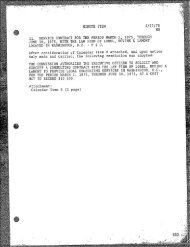Mooring Loads Due to Parallel Passing Ships - State Lands ...
Mooring Loads Due to Parallel Passing Ships - State Lands ...
Mooring Loads Due to Parallel Passing Ships - State Lands ...
You also want an ePaper? Increase the reach of your titles
YUMPU automatically turns print PDFs into web optimized ePapers that Google loves.
Figure 10. Sample data showing typical measured force and moment records<br />
along with low pass filtering.<br />
One feature shown in Figure 10 is the filtering of the raw data <strong>to</strong> remove various<br />
high frequency oscillations. The interest in these tests is in the effects of the primary<br />
pressure field which produces low frequency loads on the moored ship. Measurements,<br />
however, also included effects of the secondary waves (diverging and transverse shipgenerated<br />
waves). These were not <strong>to</strong>o evident at the slowest speed tested but became<br />
increasingly evident at higher speeds.<br />
In addition, the moored ship exhibited motions at frequencies corresponding <strong>to</strong><br />
its natural frequencies in surge and sway. Tests were conducted <strong>to</strong> determine these<br />
natural frequencies and it was found that the surge frequency was 3.2 Hz while the<br />
sway frequency was about 6 Hz.<br />
In order <strong>to</strong> remove these higher frequency effects, the raw data was filtered<br />
using a low-pass filter with a 2 Hz cu<strong>to</strong>ff frequency. As shown in Figure 10, this<br />
effectively removed the high-frequency loads and isolated the low frequency loads of<br />
interest. Similar filtering was done by Remery (1974), although it appears that the<br />
filtering was done by simply hand-smoothing the data.<br />
NFESC TR-6056-OCN<br />
14

















